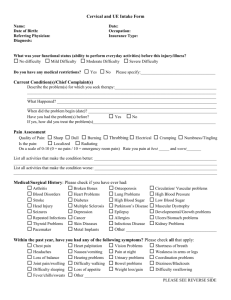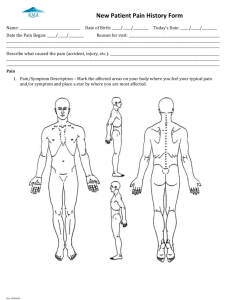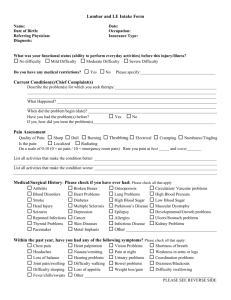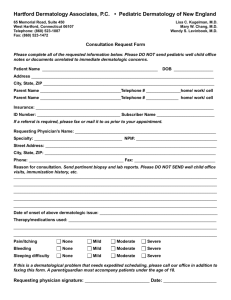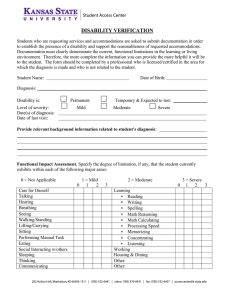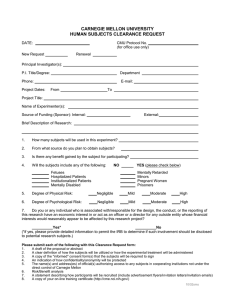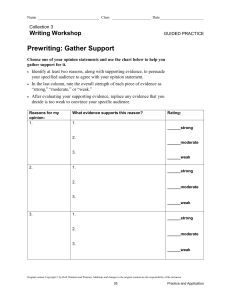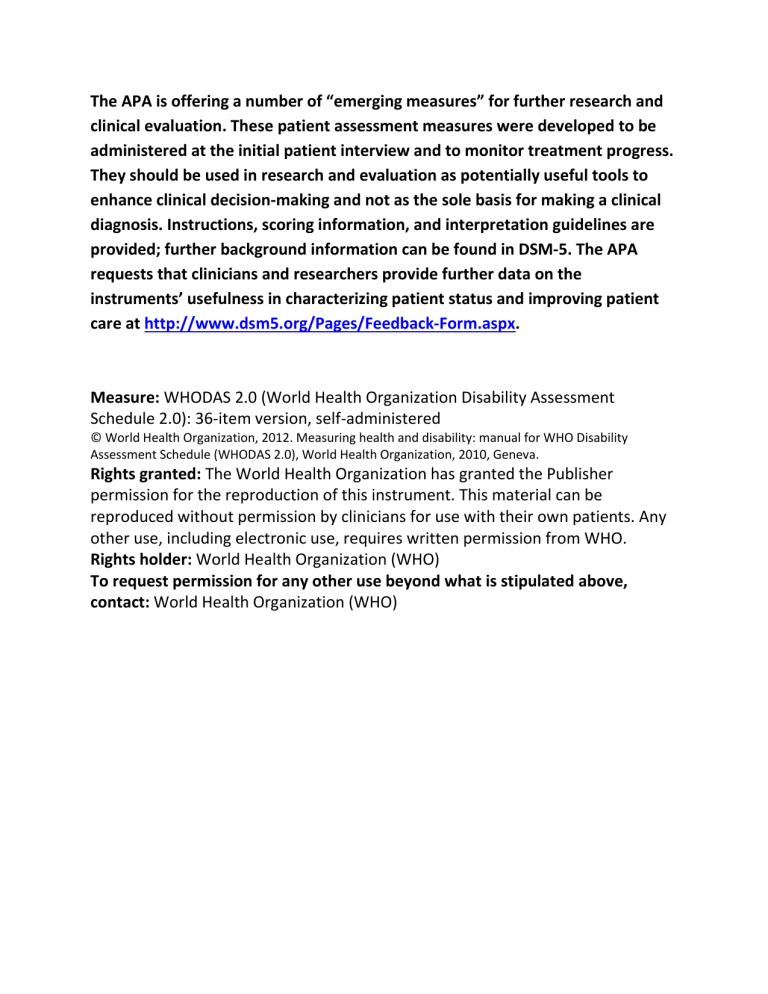
The APA is offering a number of “emerging measures” for further research and clinical evaluation. These patient assessment measures were developed to be administered at the initial patient interview and to monitor treatment progress. They should be used in research and evaluation as potentially useful tools to enhance clinical decision-making and not as the sole basis for making a clinical diagnosis. Instructions, scoring information, and interpretation guidelines are provided; further background information can be found in DSM-5. The APA requests that clinicians and researchers provide further data on the instruments’ usefulness in characterizing patient status and improving patient care at http://www.dsm5.org/Pages/Feedback-Form.aspx. Measure: WHODAS 2.0 (World Health Organization Disability Assessment Schedule 2.0): 36-item version, self-administered © World Health Organization, 2012. Measuring health and disability: manual for WHO Disability Assessment Schedule (WHODAS 2.0), World Health Organization, 2010, Geneva. Rights granted: The World Health Organization has granted the Publisher permission for the reproduction of this instrument. This material can be reproduced without permission by clinicians for use with their own patients. Any other use, including electronic use, requires written permission from WHO. Rights holder: World Health Organization (WHO) To request permission for any other use beyond what is stipulated above, contact: World Health Organization (WHO) WHODAS 2.0 World Health Organization Disability Assessment Schedule 2.0 36-item version, self-administered Patient Name: _______________________ Age: ______ Sex: Male Female Date:_____________ This questionnaire asks about difficulties due to health/mental health conditions. Health conditions include diseases or illnesses, other health problems that may be short or long lasting, injuries, mental or emotional problems, and problems with alcohol or drugs. Think back over the past 30 days and answer these questions thinking about how much difficulty you had doing the following activities. For each question, please circle only one response. 1 2 3 4 5 In the last 30 days, how much difficulty did you have in: Understanding and communicating D1.1 Concentrating on doing something for ten minutes? None Mild Moderate Severe Extreme or cannot do D1.2 Remembering to do important things? None Mild Moderate Severe Extreme or cannot do None Mild Moderate Severe Extreme or cannot do None Mild Moderate Severe Extreme or cannot do D1.3 D1.4 Analyzing and finding solutions to problems in day-to-day life? Learning a new task, for example, learning how to get to a new place? D1.5 Generally understanding what people say? None Mild Moderate Severe D1.6 Starting and maintaining a conversation? None Mild Moderate Severe Raw Domain Score Average Domain Score Numeric scores assigned to each of the items: Raw Item Score Clinician Use Only ____ 30 ____ 5 ____ 25 ____ 5 ____ 20 ____ 5 ____ 25 ____ 5 Extreme or cannot do Extreme or cannot do Getting around D2.1 Standing for long periods, such as 30 minutes? None Mild Moderate Severe D2.2 Standing up from sitting down? None Mild Moderate Severe D2.3 Moving around inside your home? None Mild Moderate Severe D2.4 Getting out of your home? None Mild Moderate Severe None Mild Moderate Severe Walking a long distance, such as a kilometer (or equivalent)? Self-care D2.5 D3.1 Washing your whole body? None Mild Moderate Severe D3.2 Getting dressed? None Mild Moderate Severe D3.3 Eating? None Mild Moderate Severe D3.4 Staying by yourself for a few days? None Mild Moderate Severe Extreme or cannot do Extreme or cannot do Extreme or cannot do Extreme or cannot do Extreme or cannot do Extreme or cannot do Extreme or cannot do Extreme or cannot do Extreme or cannot do Getting along with people D4.1 Dealing with people you do not know? None Mild Moderate Severe D4.2 Maintaining a friendship? None Mild Moderate Severe D4.3 Getting along with people who are close to you? None Mild Moderate Severe D4.4 Making new friends? None Mild Moderate Severe D4.5 Sexual activities? None Mild Moderate Severe Extreme or cannot do Extreme or cannot do Extreme or cannot do Extreme or cannot do Extreme or cannot do 1 2 3 4 5 In the last 30 days, how much difficulty did you have in: Life activities—Household D5.1 Taking care of your household responsibilities? None Mild Moderate Severe D5.2 Doing most important household tasks well? None Mild Moderate Severe Extreme or cannot do Extreme or cannot do ____ 20 ____ 5 ____ 20 ____ 5 ____ 40 ____ 5 ____ General Disability Score (Total): 180 ____ 5 Getting all of the household work done that Extreme or None Mild Moderate Severe cannot do you needed to do? Getting your household work done as quickly as Extreme or None Mild Moderate Severe D5.4 cannot do needed? Life activities—School/Work If you work (paid, non-paid, self-employed) or go to school, complete questions D5.5–D5.8, below. Otherwise, skip to D6.1. Because of your health condition, in the past 30 days, how much difficulty did you have in: D5.3 D5.5 D5.6 D5.7 D5.8 Your day-to-day work/school? Doing your most important work/school tasks well? Getting all of the work done that you need to do? Getting your work done as quickly as needed? Participation in society In the past 30 days: How much of a problem did you have in joining in community activities (for example, festivities, D6.1 religious, or other activities) in the same way as anyone else can? D6.2 D6.3 D6.4 D6.5 D6.6 D6.7 D6.8 How much of a problem did you have because of barriers or hindrances around you? How much of a problem did you have living with dignity because of the attitudes and actions of others? How much time did you spend on your health condition or its consequences? How much have you been emotionally affected by your health condition? How much has your health been a drain on the financial resources of you or your family? How much of a problem did your family have because of your health problems? How much of a problem did you have in doing things by yourself for relaxation or pleasure? Raw Domain Score Average Domain Score Numeric scores assigned to each of the items: Raw Item Score Clinician Use Only None Mild Moderate Severe Extreme or cannot do None Mild Moderate Severe Extreme or cannot do None Mild Moderate Severe Extreme or cannot do None Mild Moderate Severe Extreme or cannot do None Mild Moderate Severe Extreme or cannot do None Mild Moderate Severe None Mild Moderate Severe Extreme or cannot do Extreme or cannot do None Some Moderate A Lot Extreme or cannot do None Mild Moderate Severe Extreme or cannot do None Mild Moderate Severe Extreme or cannot do None Mild Moderate Severe Extreme or cannot do None Mild Moderate Severe Extreme or cannot do © World Health Organization, 2012. All rights reserved. Measuring health and disability: manual for WHO Disability Assessment Schedule (WHODAS 2.0), World Health Organization, 2010, Geneva. The World Health Organization has granted the Publisher permission for the reproduction of this instrument. This material can be reproduced without permission by clinicians for use with their own patients. Any other use, including electronic use, requires written permission from WHO. WHODAS 2.0 World Health Organization Disability Assessment Schedule 2.0 36-item version, self-administered The adult self-administered version of the World Health Organization Disability Assessment Schedule 2.0 (WHODAS 2.0) is a 36-item measure that assesses disability in adults age 18 years and older. It assesses disability across six domains, including understanding and communicating, getting around, self-care, getting along with people, life activities (i.e., household, work, and/or school activities), and participation in society. If the adult individual is of impaired capacity and unable to complete the form (e.g., a patient with dementia), a knowledgeable informant may complete the proxy-administered version of the measure, which is available at www.psychiatry.org/dsm5. Each item on the self-administered version of the WHODAS 2.0 asks the individual to rate how much difficulty he or she has had in specific areas of functioning during the past 30 days. WHODAS 2.0 Scoring Instructions Provided by World Health Organization WHODAS 2.0 Summary Scores: There are two basic options for computing the summary scores for the WHODAS 2.0 36-item full version. Simple: The scores assigned to each of the items—“none” (1), “mild” (2), “moderate” (3), “severe” (4), and “extreme” (5)—are summed. This method is referred to as simple scoring because the scores from each of the items are simply added up without recoding or collapsing of response categories; thus, there is no weighting of individual items. This approach is practical to use as a hand-scoring approach, and may be the method of choice in busy clinical settings or in paper-and-pencil interview situations. As a result, the simple sum of the scores of the items across all domains constitutes a statistic that is sufficient to describe the degree of functional limitations. Complex: The more complex method of scoring is called “item-response-theory” (IRT)–based scoring. It takes into account multiple levels of difficulty for each WHODAS 2.0 item. It takes the coding for each item response as “none,” “mild,” “moderate,” “severe,” and “extreme” separately, and then uses a computer to determine the summary score by differentially weighting the items and the levels of severity. The computer program is available from the WHO Web site. The scoring has three steps: • • • Step 1—Summing of recoded item scores within each domain. Step 2—Summing of all six domain scores. Step 3—Converting the summary score into a metric ranging from 0 to 100 (where 0 = no disability; 100 = full disability). WHODAS 2.0 Domain Scores: WHODAS 2.0 produces domain-specific scores for six different functioning domains: cognition, mobility, self-care, getting along, life activities (household and work/school) and participation. WHODAS 2.0 Population Norms: For the population norms for IRT-based scoring of the WHODAS 2.0 and for the population distribution of IRT-based scores for WHODAS 2.0, please see http://www.who.int/classifications/icf/Pop_norms_distrib_IRT_scores.pdf Additional Scoring and Interpretation Guidance for DSM-5 Users The clinician is asked to review the individual’s response on each item on the measure during the clinical interview and to indicate the self-reported score for each item in the section provided for “Clinician Use Only.” However, if the clinician determines that the score on an item should be different based on the clinical interview and other information available, he or she may indicate a corrected score in the raw item score box. Based on findings from the DSM-5 Field Trials in adult patient samples across six sites in the United States and one in Canada, DSM-5 recommends calculation and use of average scores for each domain and for general disability. The average scores are comparable to the WHODAS 5-point scale, which allows the clinician to think of the individual’s disability in terms of none (1), mild (2), moderate (3), severe (4), or extreme (5). The average domain and general disability scores were found to be reliable, easy to use, and clinically useful to the clinicians in the DSM-5 Field Trials. The average domain score is calculated by dividing the raw domain score by the number of items in the domain (e.g., if all the items within the “understanding and communicating” domain are rated as being moderate then the average domain score would be 18/6 = 3, indicating moderate disability). The average general disability score is calculated by dividing the raw overall score by number of items in the measure (i.e., 36). The individual should be encouraged to complete all of the items on the WHODAS 2.0. If no response is given on 10 or more items of the measure (i.e., more than 25% of the 36 total items), calculation of the simple and average general disability scores may not be helpful. If 10 or more of the total items on the measure are missing but the items for some of the domains are 75%–100% complete, the simple or average domain scores may be used for those domains. Frequency of Use To track change in the individual’s level of disability over time, the measure may be completed at regular intervals as clinically indicated, depending on the stability of the individual’s symptoms and treatment status. Consistently high scores on a particular domain may indicate significant and problematic areas for the individual that might warrant further assessment and intervention.
